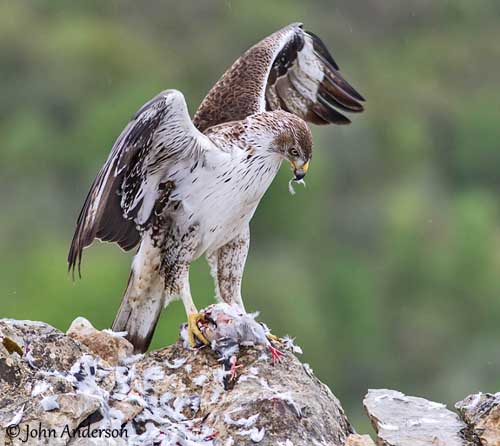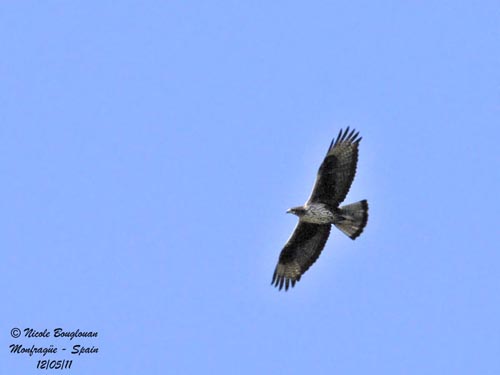
Fr: Aigle de Bonelli
All: Habichtsadler
Esp: Águila-azor Perdicera
Ital: Aquila del Bonelli
Nd: Havikarend
Sd: Hökörn
Photographers:
John Anderson
John Anderson Photo Galleries
Ingo Waschkies
Bird Photography
Nicole Bouglouan
PHOTOGRAPHIC RAMBLE
Text by Nicole Bouglouan
Sources:
HANDBOOK OF THE BIRDS OF THE WORLD Vol 2 by Josep del Hoyo-Andrew Elliot-Jordi Sargatal - Lynx Edicions - ISBN: 8487334156
GUIDE DES RAPACES DIURNES – Europe, Afrique du Nord et Moyen-Orient de Benny Génsbol – Delachaux et Niestlé – ISBN : 2603013270
A Field Guide to the Birds of South-East Asia by Craig Robson. New Holland Publishers. ISBN: 9781780090498
BirdLife International (BirdLife International)
Global Raptor Information Network - Working to Conserve Birds of Prey in nature
Wikipedia, the free encyclopaedia
Bonelli’s Eagle
Aquila fasciata
Accipitriforme Order – Accipitridae Family
INTRODUCTION:
Recent genetic research has led to the new classification of this species. Formerly Hieraaetus fasciatus, the Bonelli’s Eagle is today Aquila fasciata.
The genus Aquila includes large, dark eagles, but due to recent DNA research, this species belongs now to the genus Aquila which contains the true species of “booted” eagles with feathered tarsi, three toes pointing forwards and a hind toe armed with the longest claw.
This change from Hieraaetus to Aquila involves new scientific name, from “fasciatus” to “fasciata”.
This eagle has been discovered by Franco Andrea Bonelli (1784-1830), an Italian ornithologist, entomologist and collector.

DESCRIPTION OF THE BIRD:
Biometrics:
Length: 65-72 cm
Wingspan: M: 150-160 cm – F: 165-180 cm
Weight: 1600-2400 g
The adult has relatively short, rounded wings and long tail. The upperparts are dark brown with pale, whitish area on back contrasting with the dark sides. On the upperwing, the flight feathers are dark brown. The tail is grey with several narrow dark bands and broad dark subterminal band.
The underparts are white, finely streaked black, including on the underwing-coverts. We can see white leading edge and carpal joint. The flight feathers are pale grey with dark bars and blackish tips.
On the head, forehead, crown, nape and cheeks are brown, finely streaked white. We can see a white supercilium. Chin and throat are white too.
The bill is grey with darker tip and yellow cere. The eyes are pale yellow. Legs and feet are yellow with sharp black claws.
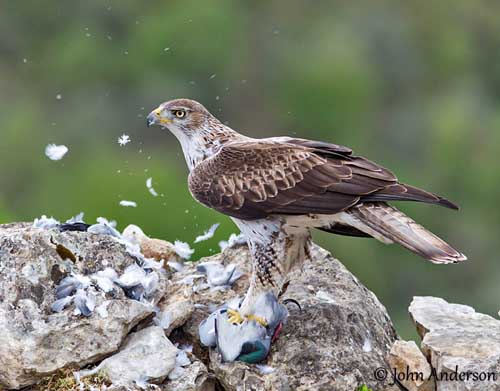
The female is larger, with more heavily streaked underparts. She has yellow-orange eyes.
The juvenile is darker brown above. The underparts are pale rufous, rarely white. The underwing-coverts are dusky. The pale dorsal area is sometimes visible but reduced.
The immature is much paler below, with dark median-coverts forming a blackish band. The whitish dorsal patch becomes more visible. The eyes are darker than in adults.
SUBSPECIES AND RANGE:
The Bonelli’s Eagle has two subspecies.
A.f. fasciata (here described and displayed) occurs in NW Africa and Iberian Peninsula, E through Mediterranean, SW Asia and Arabia to Afghanistan, Pakistan and India and through N Indochina to S China.
A.f. renschi (immature displayed too) is found in Sumbawa, Timor, Wetar, Luang, and probably Flores in the Lesser Sunda Islands. This race is smaller, with more barring on wings and tail feathers.

A.f. renschi
Immature
HABITAT:
The Bonelli’s Eagle frequents mainly mountainous areas with crags and cliffs for nesting. This species hunts in bushy and shrubby areas, maquis or garrigue, and barren slopes. It can also be found in flat open areas such as pastures and cultivated fields. Outside the breeding season, it frequents wetlands.
This species occurs mainly at low or medium elevations, but according to the range, it is visible up to 2000 metres and more in NW Africa and Asia.
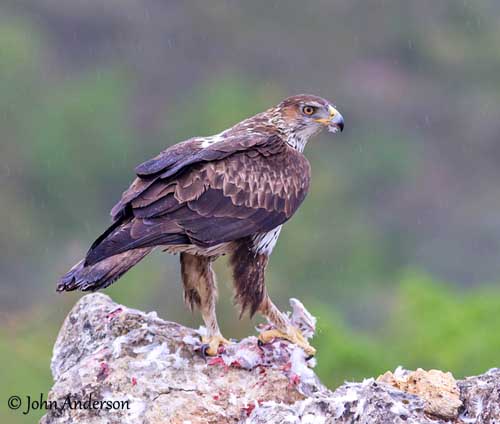
CALLS AND SONGS: SOUNDS BY XENO-CANTO
The Bonelli’s Eagle is fairly silent outside the breeding period. But during the flight displays, it gives a repeated, shrill and melodious “iuh” and a longer whistled “eeeoo” lower-pitched at the end.
BEHAVIOUR IN THE WILD:
The Bonelli’s Eagle feeds on medium-sized birds and mammals such as rabbits and Red-legged Partridges. But numerous other birds like pigeons, crows, ducks, gulls and other species as large as herons are also taken. Lizards, rodents and squirrels can be taken too.
This eagle is a powerful hunter, and larger preys such as storks, herons, buzzards and foxes are killed.
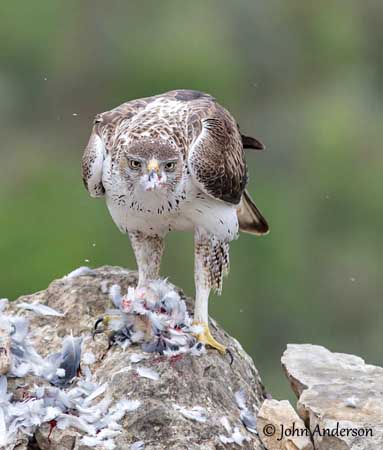
Most of preys are caught on the ground, but flying birds can be caught thanks to the agile flight. Birds are usually taken at take-off, but the Bonelli’s Eagle also pursues its preys over long distance among trees and bushes.
Breeding colonies of gulls and herons are raided by pairs hunting together. This eagle also hunts from cover, perched in tree foliage before to perform a quick attack, or by soaring and stooping.
The Bonelli’s Eagle is territorial and defends its area, and especially the nest and its surroundings during the breeding and nesting periods. Direct physical encounters are rare. The owner uses a warning system to inform neighbours and intruders of the occupancy of the territory, usually a peculiar flight.
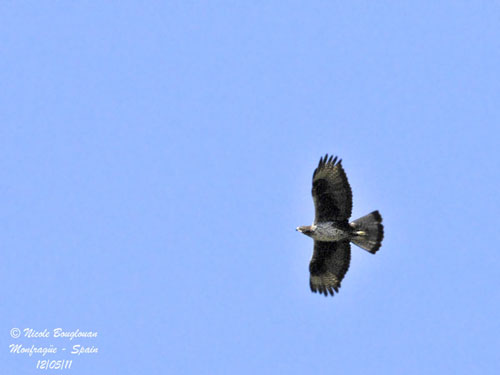
Like numerous eagles, both mates perform aerial displays. They circle above the breeding site, and perform strong undulating flight display with steep dives and upwards swoop, rarely with wing-flapping.
The pair soars over the breeding territory and may call occasionally. Displays usually continue, but less often, through the breeding period. They are monogamous with long-term pair-bonds.

The Bonelli’s Eagle is sedentary and dispersive. The juveniles disperse as soon as they are independent. They usually move to agricultural areas where there are abundant food resources. They often travel hundreds of kilometres from their natal territory.
The Bonelli’s Eagle performs glides on flat wings. This eagle is rapid and agile when hunting or performing flight displays. Its flight is powerful.
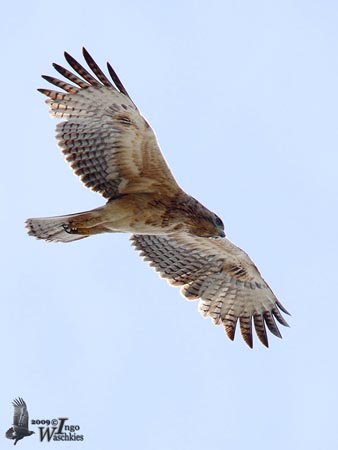
A.f. renschi
Immature
REPRODUCTION OF THIS SPECIES:
The breeding season takes place between November and February throughout much of the Indian subcontinent, and February/April in the Mediterranean regions.
The Bonelli’s Eagle nests on cliff ledges, rarely in trees. The stick nest is bulky and may reach two metres wide and one metre height. It is lined with green leaves. Like numerous raptors, the pair has several nests, often close to each other and on the same cliff face. They use them alternately. After consecutive years, they become huge.
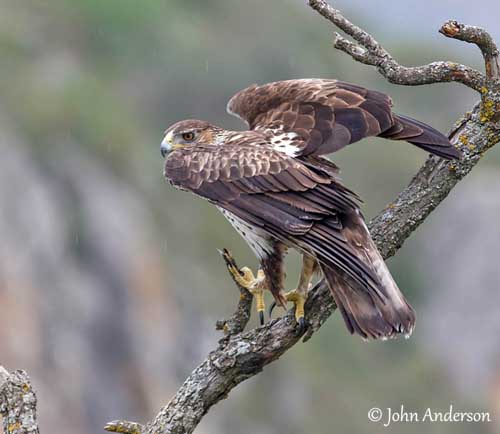
The female lays 1-2 eggs, and incubates during 37-40 days, while the male feeds her at nest or near the nest. She broods and feeds the chicks with the preys brought by the male, but later, the adults hunt together.
The white downy chicks fledge about 60-70 days after hatching, and stay in the territory during several months. They often follow the adults when hunting.
Both young survive in about 20% of nests.
PROTECTION / THREATS / STATUS:
The Bonelli’s Eagle is one of the most endangered eagles in Europe, with several declines due to accidents with powerlines and direct persecution, degradation and changes in the habitat, reduction of preys and disturbances.
However, the species is not currently threatened, thanks to active conservation measures involving fairly stable populations.
